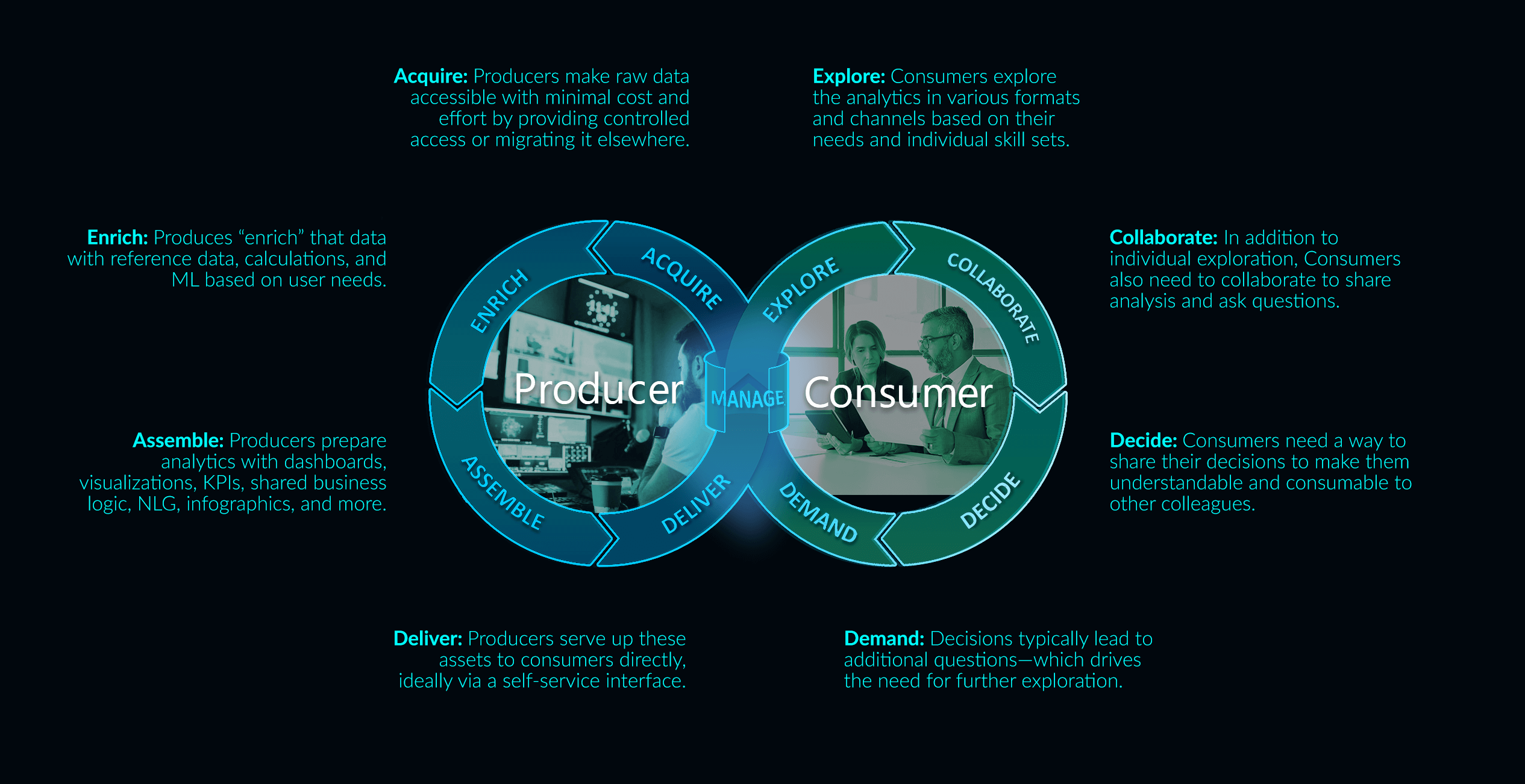A business decision supply chain contains a sequence of processes through which data owners (producers) can transform raw data into trusted and actionable business information for themselves and other users (consumers) to help make better business decisions. When integrated into a modern, cloud-ready, self-service analytics platform, users across the organization can collaborate with data to experience transformative changes.
This is part two in a five-part series that explores how Pyramid Analytics aligns to a business decision supply chain framework that can galvanize analytics for users across the enterprise—reducing time to decisions, optimizing costs, and improving change management in the process.
A new business model to manage how business decisions are made
In my first post in this series, we examined a story familiar to many business leaders: conflicting data in the board room. What starts as an earnest attempt to update colleagues on the management team about company performance quickly devolves into an argument about the validity of the data. We then looked at alternative scenario, one where easy data exploration and collaboration leads to discussing the best thing to do for the business.
The latter scenario illustrates a collaborative decision-making dynamic driven by a process we call the Business Decision Supply Chain. It’s a continual, iterative process through which analytics producers and consumers work from a common data and analytics platform that provides a user experience tailored to their individual needs—reducing time to decisions, optimizing costs, and improving change management in the process.
The Business Decision Supply Chain in motion
A modern analytics platform that features democratized access, sophisticated governance, and robust self-service capabilities make it possible.
Consider how producers and consumers can operate in this model within a consolidated analytics environment. The Business Decision Supply Chain (pictured below) resembles the mathematical symbol for infinity (∞), and for good reason: it’s designed to continually flow in a virtuous flywheel-type motion.

The Business Decision Supply Chain consists of discrete steps that allow Consumers (those who need data to make decisions) and Producers (those who prepare data for Consumers) to work together in a continuous cycle.
Under the right conditions, consumers can explore data and collaborate with each other—without constantly having to request more content from producers. As new questions arise, producing the need for more and different analytics, consumers can communicate that demand to producers.
As a result, consumers can make quicker decisions about rapidly changing market conditions with real-time results from producers, delivered in response to their data demands. This solves the problem of availability while also relieving the need for consumers to do manual reporting, often done in Excel.
Next, let’s take a closer look at each side of the diagram, and the discrete steps in each.
The four responsibilities of modern analytics producers
There are four distinct responsibilities that fall under the analytics producers’ purview. Here are the four stages, combined into two segments:
- Acquire & Enrich: The process starts with raw data—which is typically kept in various formats in operational data stores not easily accessible or designed for analytics use. The producers’ first job is to make that raw data securely accessible with minimal cost and effort by providing controlled access or migrating it to a more appropriate place; they then “enrich” that data with reference data, calculations, and Machine Learning based on end-user needs so that consumers can understand and leverage it.
- Assemble & Deliver: Producers prepare analytics for consumers with dashboards, visualizations, KPIs, shared business logic, natural language generation, infographics, and other features that make the analytics consumable. They serve up these assets to consumers directly, ideally via a purpose-built, self-service interface that consumers can access.
Through these processes, data is unlocked and delivered to support business decision-making through a streamlined process. With the right tools, that data remains highly secure—data assets can be governed and managed, and data managers know who is accessing data, all in a single environment.
The four responsibilities of modern data consumers
Based on this new model, there are also four distinct activities in which consumers engage. They are:
- Explore: Consumers explore the analytics in various formats and channels based on their needs and individual skill sets. A “Smart” platform meets the needs of all possible consumers, no matter their level of data proficiency.
- Collaborate: Individual exploration is only one-half of consumer activity. Consumers also need to interact—to collaborate—to share analysis, ask questions, and provide explanations. This activity is as important as the explanation itself and needs to be equally supported and valued.
- Decide: Consumers need a vehicle to share their decisions in a way that helps make them understandable and consumable to other colleagues, even in other departments and at different levels of seniority. Business leaders who are audiences to their data storytelling know the data is timely and accurate since it comes from a single universally trusted platform.
- Demand: Decisions typically lead to additional questions—which drives the need for further exploration from consumers and acquisition from producers. In this sense, this process perpetuates itself and continues the cycle again.
When analytics is consistently delivered to the right consumers in actionable formats they understand, they consistently make better decisions to meet new business challenges. At our fictional sports retailer example at X Sports, both executives and the head of operations always know how to get to the data and analytics they need, even as the business changes.
A Business Decision Supply Chain to facilitate relationships that drive results
When integrated into a modern, self-service analytics platform, a business decision supply chain can drive collaboration and point the way to transformative changes—driven by data. Providing analytics consumers with ready access to correct and up-to-date data allows for faster, more confident decisions and shorter time to market. Critically, their access doesn’t require direct and impromptu support from IT teams. And because all team members know the data they are using is accurate and comes from trusted sources, they become agile decision makers.
Pyramid Analytics is a leading analytics platform, trusted by enterprises across the globe to support their own business decision supply chains. With Pyramid, technology leaders continuously supply self-sustaining insights to business users through a supply chain approach. They can empower their organizations with data and analytics in a manageable and governed way, removing the burden of being the sole provider. This dramatically reduces IT costs and improves the speed of decision-making beyond what’s possible with other solutions.
In future posts, we will take a closer look at each individual stage of the cycles that constitute the successful modern relationship between data producers and consumers. Meanwhile, you can contact one of our analytics experts or request a free demonstration to learn more about facilitating these relationships in your own organization.
This post is a part of our five-part series on the Business Decision Supply Chain. Revisit any of the other posts to learn more:













